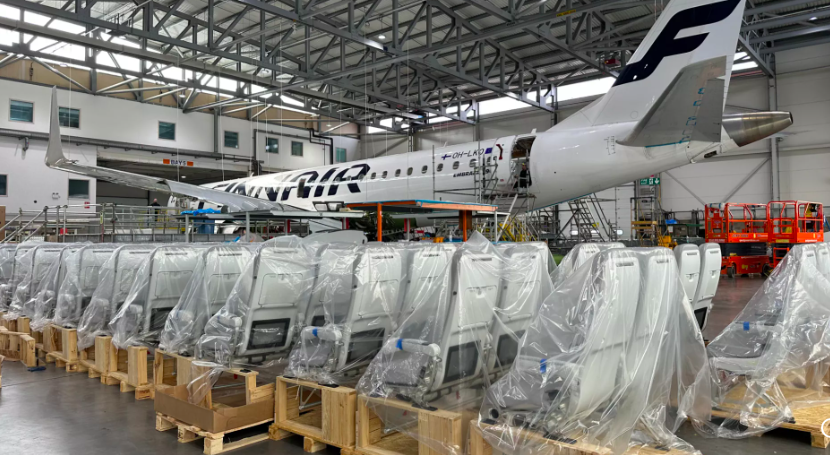"Revitalizing Old Jets: Enhancing Sustainability and Comfort Through Cabin Refurbishments"

Airlines Hold Onto Aging Aircraft as Demand Surges: The Hidden Makeover
The aviation industry is experiencing a paradox. While air travel demand continues to surge, airlines are holding onto their planes for longer, working hard to ensure passengers never notice. The pandemic’s impact lingers, disrupting supply chains and delaying aircraft deliveries. As a result, many airlines have embarked on ambitious refurbishment programs, investing billions in modernising their older fleets with state-of-the-art interiors.
Why Are Airlines Holding Onto Older Aircraft?
The post-pandemic aviation recovery has been slow, with supply chain disruptions still affecting aircraft production. Manufacturers like Boeing and Airbus have struggled to meet delivery schedules, forcing airlines to extend the operational life of their existing fleets. The global average aircraft age has risen to a record high of 14.8 years, up from 13 years pre-pandemic, according to IATA.
Emirates, for instance, expected to receive its first Boeing 777X aircraft in 2020. However, continuous delays have pushed deliveries to at least 2026, leading the airline to invest $5 billion (€4.6 billion) in refurbishing 220 aircraft. Similarly, Etihad is spending $1 billion (€920 million) to revamp its Boeing 777 and 787 aircraft as new planes remain unavailable.
Making Old Planes Look New Again
Typically, airlines debut new cabin designs on fresh aircraft. However, with delivery delays, airlines are implementing these updates on existing planes instead. The upgrades range from new seating and carpets to enhanced in-flight entertainment systems and improved passenger amenities.
Finnair, for example, recently completed an overhaul of its Airbus A330 long-haul fleet and is now focusing on its 12 Embraer E190 regional jets, some of which are nearly 19 years old. The airline has introduced fresh interiors featuring modern seats, improved legroom, and updated materials to align with its newer A350s. By spring 2026, all 12 aircraft will sport the new cabins.
To minimize service disruption, Finnair strategically schedules refurbishments alongside routine maintenance, reducing aircraft downtime. Similar approaches are being adopted across the industry, ensuring that upgraded cabins enhance passenger experience without affecting flight availability.
The Environmental Challenge of an Aging Fleet
While these refurbishments improve comfort, they do not address one of aviation’s biggest challenges—reducing carbon emissions. New aircraft are up to 20% more fuel-efficient than older models, making fleet renewal a crucial step toward aviation’s net-zero goals. The delay in aircraft deliveries means airlines must rely on older, less efficient planes, slowing the industry's progress toward sustainability.
Willie Walsh, director general of IATA, has criticised manufacturers for failing to meet their commitments, stating, “Manufacturers are letting down their airline customers, and that is having a direct impact on slowing airlines’ efforts to limit their carbon emissions.”
The Future of Airline Fleets
Despite these challenges, airlines continue to expand their networks, relying on refurbished aircraft to bridge the gap until new deliveries arrive. With air travel demand showing no signs of slowing, airlines will need to balance passenger comfort, operational efficiency, and environmental responsibility.
For now, while passengers may be flying on older aircraft, they might not even notice—thanks to billion-dollar refurbishments ensuring their journey feels as modern as ever.
Conclusion
The airline industry's reliance on older aircraft is a necessary response to ongoing supply chain disruptions and production delays. By investing in cabin refurbishments, airlines are ensuring passengers continue to enjoy modern, comfortable flights even as they wait for new aircraft. However, the environmental concerns associated with keeping aging fleets in operation remain a pressing issue. As manufacturers work to resolve production challenges, airlines will need to find a balance between sustainability and meeting the ever-growing demand for air travel. In the meantime, passengers can expect refreshed interiors that make their flights feel as seamless as ever, even if the aircraft itself has been in service for years.
- Art
- Causes
- Crafts
- Dance
- Drinks
- Film
- Fitness
- Food
- Games
- Gardening
- Health
- Home
- Literature
- Music
- Networking
- Other
- Party
- Religion
- Shopping
- Sports
- Theater
- Wellness


